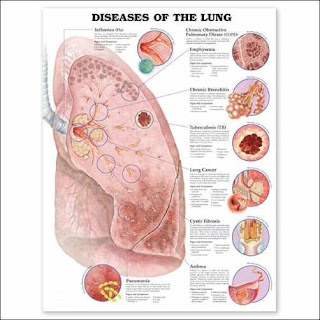Lung diseases are some of the most common medical conditions worldwide. Tens of millions of people suffer from lung disease in the U.S. Smoking, infections, and genetics are responsible for most lung diseases.
The lungs are part of a complex apparatus, expanding and relaxing thousands of times daily to bring in oxygen and expel carbon dioxide. Lung disease can result from problems in any part of this system.

The trachea (windpipe) branches into tubes called bronchi, which in turn branch to become progressively smaller tubes throughout the lungs. Diseases that affect the airways include:

Chronic obstructive pulmonary disease (COPD): Lung conditions defined by an inability to exhale normally, which causes difficulty breathing.
Chronic bronchitis: A form of COPD characterized by a chronic productive cough.
Emphysema: Lung damage allows air to be trapped in the lungs in this form of COPD. Difficulty blowing air out is its hallmark.
Acute bronchitis: A sudden infection of the airways, usually by a virus.
Cystic fibrosis: A genetic condition causing poor clearance of mucus from the bronchi. The accumulated mucus results in repeated lung infections.
The airways eventually branch into tiny tubes (bronchioles) that dead-end into clusters of air sacs called alveoli. These air sacs make up most of the lung tissue. Lung diseases affecting the alveoli include:
Tuberculosis: A slowly progressive pneumonia caused by the bacteria Mycobacterium tuberculosis.
Emphysema results from damage to the fragile connections between alveoli. Smoking is the usual cause. (Emphysema also limits airflow, affecting the airways as well.)
Pulmonary edema: Fluid leaks out of the small blood vessels of the lung into the air sacs and the surrounding area. One form is caused by heart failure and back pressure in the lungs' blood vessels; in another form, direct injury to the lung causes the leak of fluid.
Lung cancer has many forms, and may develop in any part of the lungs. Most often this is in the main part of the lung, in or near the air sacs. The type, location, and spread of lung cancer determines the treatment options.
Acute respiratory distress syndrome (ARDS): Severe, sudden injury to the lungs caused by a serious illness. Life support with mechanical ventilation is usually needed to survive until the lungs recover.
Pneumoconiosis: A category of conditions caused by the inhalation of a substance that injures the lungs. Examples include black lung disease from inhaled coal dust and asbestosis from inhaled asbestos dust.
The interstitium is the microscopically thin, delicate lining between the lungs' air sacs (alveoli). Tiny blood vessels run through the interstitium and allow gas exchange between the alveoli and the blood. Various lung diseases affect the interstitium:
Pneumonias and pulmonary edemas can also affect the interstitium.
Lung Diseases Affecting Blood Vessels
The right side of the heart receives low-oxygen blood from the veins. It pumps blood into the lungs through the pulmonary arteries. These blood vessels can suffer from disease, as well.
Pulmonary hypertension: Various conditions can lead to high blood pressure in the pulmonary arteries. This can cause shortness of breath and chest pain. When no cause is identified, the condition is called idiopathic pulmonary arterial hypertension.
The pleura is a thin lining that surrounds the lung and lines the inside of the chest wall. A tiny layer of fluid allows the pleura on the lung's surface to slide along the chest wall with each breath. Lung diseases of the pleura include:
Pneumothorax: Air may enter the space between the chest wall and the lung, collapsing the lung. To remove the air, a tube is typically inserted through the chest wall.
Mesothelioma: A rare form of cancer that forms on the pleura. Mesothelioma tends to emerge several decades after asbestos exposure.
The chest wall also plays an important role in breathing. Muscles connect the ribs to each other, helping the chest to expand. The diaphragm descends with each breath in, also causing chest expansion.
Neuromuscular disorders: Poor function in the nerves controlling the respiratory muscles causes difficulty breathing. Amyotrophic lateral sclerosis and myasthenia gravis are examples of neuromuscular lung disease.
